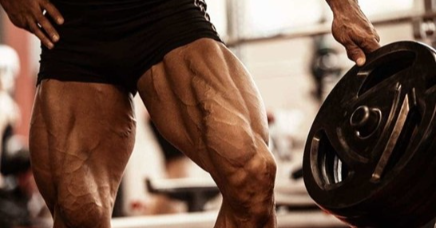Partial Reps for Massive Arms? Study: 20% Greater Gains

PARTIAL REPS FOR TOTAL GAINS
You play by the rules. You eat your veggies, get plenty of sleep, and of course – always use perfect form. So why aren’t your triceps growing? A recent Japanese study suggest that the secret to tearing your sleeves might just involve breaking one of bodybuilding’s most sacred rules.
Researcher Masahiro Goto and his team compared the effects of full-range of motion tricep extensions with those of partial range of motion triceps extensions over an 8-week period. Translated from geek: they had two groups of athletes do Skulls Crushers (laying on a bench, barbell lowered to or above forehead).
One group lowered the bar completely with perfect form (0° to 120° of elbow flexion) while the other used Partial Reps, “pumping” the weight near the middle of the range of motion, not lowering the bar completely and not locking out each rep at the top (45° to 90° of elbow flexion).

THE RESULTS
Naturally, the Muscle-gods rewarded the good form group, right? Wrong. Over the 8-week period, the Partial Reps group gained 20% more triceps mass than the by-the-book reppers. As the study more eloquently put it, researchers determined the half-reppers had achieved “a highly significant difference in the increase in cross-sectional area of the triceps brachii”.
Researchers found that in the Partial Reps group, the localized increase in lactate and blood volume due to the “pump” sent anabolism sky-rocketing (if that terminology sounds familiar, it may be because UNTAPPED harnesses the same mechanism to accelerate muscle-growth).
Because the partial reps placed the muscle in a constant, high pressure state of contraction and/or weighted stretch, blood flow into the muscle was greater than the rate blood (and lactate) could exit the muscle – this creates the pump and stimulates greater gains, the researchers theorize.
In the full range of motion group, the momentary “relaxed” phase (at lockout and at the very bottom of reps) reduced the pump effect. This allowed for a lower pressure environment, where nutrient-rich blood and lactate exited the muscle more quickly.
For those looking to follow the study exactly, participants in both groups performed their skull crushers using their 8 Rep Max (the heaviest weight they could use for 8 reps); both groups used the same weight and the same number of reps and sets (3 sets were used for the study).
What about strength? At the end of 8 weeks, both groups had similar increases in strength, and both groups gained size – but the Partial Rep group gained a lot more size.
PUTTING IT TO GOOD USE
So now I can gleefully half-rep all my squats, right? Don’t get carried away. The research cautions that the addition of partial reps as a training method is best limited to single joint, non-weight bearing movements (tricep extensions, bicep curls, lateral raises, quad extensions on a machine, to list some examples), where a muscle can be relatively isolated and the pump effect is localized.
Multi-joint exercises, involving many different muscle groups working together (squats, deadlifts, rows, pressing movements) are unquestionably more effective for strength as well as mass gains when done with a complete range of motion.
But I can at least quit doing full range of motion on triceps and curls? It’s possible, at least theoretically. But we would still recommend doing full range of motion sets of these lifts as well as partial rep sets, as a combination of the two methods may yield even greater gains than those seen in the strict, Black and White environment the study used to demonstrate the difference.
RECOMMENDED: WHAT IS UNTAPPED?
REFERENCES
Goto, Masahiro, et al. "Partial range of motion exercise is effective for facilitating muscle hypertrophy and function via sustained intramuscular hypoxia in young trained men." The Journal of Strength & Conditioning Research (2017).
Also in News

14 Essential Tips for Unstoppable Muscle
A handy check list to make this year your strongest, most muscular, leanest year ever. Bookmark this one, it's the 14 Commandments of Fitness.

Upper Chest Won't Grow? It's the Bench Angle.
Your upper chest is flat because your incline bench angle is sabotaging you. One simple adjustment changes everything.

How to Build Legs When Gym's Busy AF
Gym's packed and you can't get a squat rack or a leg press? All you need is 1 heavy dumbbell and you'll never sweat a crowded gym again. Here's the play...


